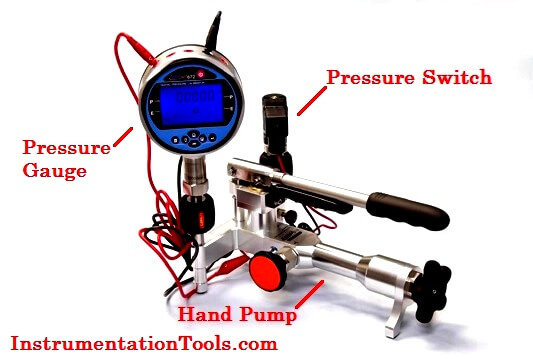Pressure switches are commonly used in the process industry for a wide range of applications. A pressure switch is a form of sensor that closes or opens an electrical contact when a certain pressure has been obtained either through a pressure rise or a pressure drop.
Pressure switches are used to monitor, control, or provide a caution or warning for a pressure related process. The repeatability, accuracy, and functionality of a pressure switch often tie directly into the safety or efficiency of a process and thus it becomes important that pressure switches are verified and calibrated to ensure their proper function in the process.
Pressure Switch Calibration
There are several terms that describe the function of a switch which need to be understood when testing a pressure switch:
Set point:
The pressure which the switch will change state.
Normal State:
The state of the switch when at barometric pressure or ideal state.
Depends on Pressure switch type.(typically it would be either OPEN or CLOSED).
Reset:
The pressure at which the switch resets back to the normal state.
Tolerance:
The allowable variation from the set point pressure.
Repeatability:
The closeness of agreement between the results of consecutive measurements.
Dead Band:
The pressure difference between the change-of-states.
(i.e. OPEN to CLOSE or CLOSE to OPEN).
Trip Type:
This is the direction to which the change-of state should happen.
If the trip type is low, this means the change-of-state happens when the pressure is falling.
If the trip type is high, this means the change-of-state happens when the pressure is rising.
Calibration or Verifying a Pressure Switch

Before implementing the steps, you need to confirm the setpoint and the dead-band of the Pressure switch. In addition, The pressure switch must be depressurized and isolated.
Consider our Pressure Switch is a normally open switch, so we will need to test when the switch changes between open to close. Next, we’ll test the reset pressure (from closed to open) and lastly, repeat the test at least once to determine repeatability.
Required Tools:
- we must use a pressure calibrator or Multimeter (DMM) to determine the current state of the switch.
- we need to have a pressure generation device (preferably a hand pump ).
- we will need a way to measure the true pressure using a pressure calibrator or Pressure gauge.
Calibration Procedure :
- First we connect the pressure gauge and Pressure switch to the hand pump as shown in above figure.
- Then we need to measure the present status (NO/NC) of electrical output of the switch with the multimeter.Put multimeter in Continuity mode.
- Note: Here in this example our pressure switch considered is Normally open type. So when you connect the multimeter before calibration we have default Normally Open (NO) signal as output.
- With our connections complete, we are ready to perform the calibration. We do this by increasing pressure until we detect a change in the switch.
- Now increase the pressure with the help of hand pump.
- When we see the switch change state from open to close, we record the result.
- Next, we decrease the pressure till we see the switch reset (change from close to open) and record the results.
- Also record the dead band.
- Lastly, we would repeat this test at least once to determine repeatability. The difference between set point and rest pressures is the dead
band.The dead band must be within the range. The deadband & setpoint of pressure switch available on nameplate of pressure switch. - For Normally closed Pressure switch calibration also follows the same above mentioned procedure. But the default status of Normally closed type Pressure switch will have N.C. signal as output. When testing with increasing pressure the output state changes from N.C. to N.O and while on decreasing pressure the output state changes from N.O. to N.C. Remaining all steps are same. Thats it. very simple.
Thanks for sharing with us. It clearly explained pressure switch calibration and its working.
Its a superb website..pls make an app for windos……and make videos free download..
Noted.
Thanks. It was clearly noted and well understood.
Sir, this is very useful site. Plz provide calibration videos.
fantastic info!
I’m so often use this web as a reference works…thank’s sir for accessing free your web.
I really like this all, its is very useful my carrier, thank u so much…
Sir can u explain pressure switch calibration procedures raising and falling conditions while we r doing calibration…..
thank u sir, its easy to simple way clearly you mentioned procedure
Pls sent pressure transmitter calibration procedure sir
thanks u for this info. u guys are good. thanx
thanks a lot , I really appreciated.